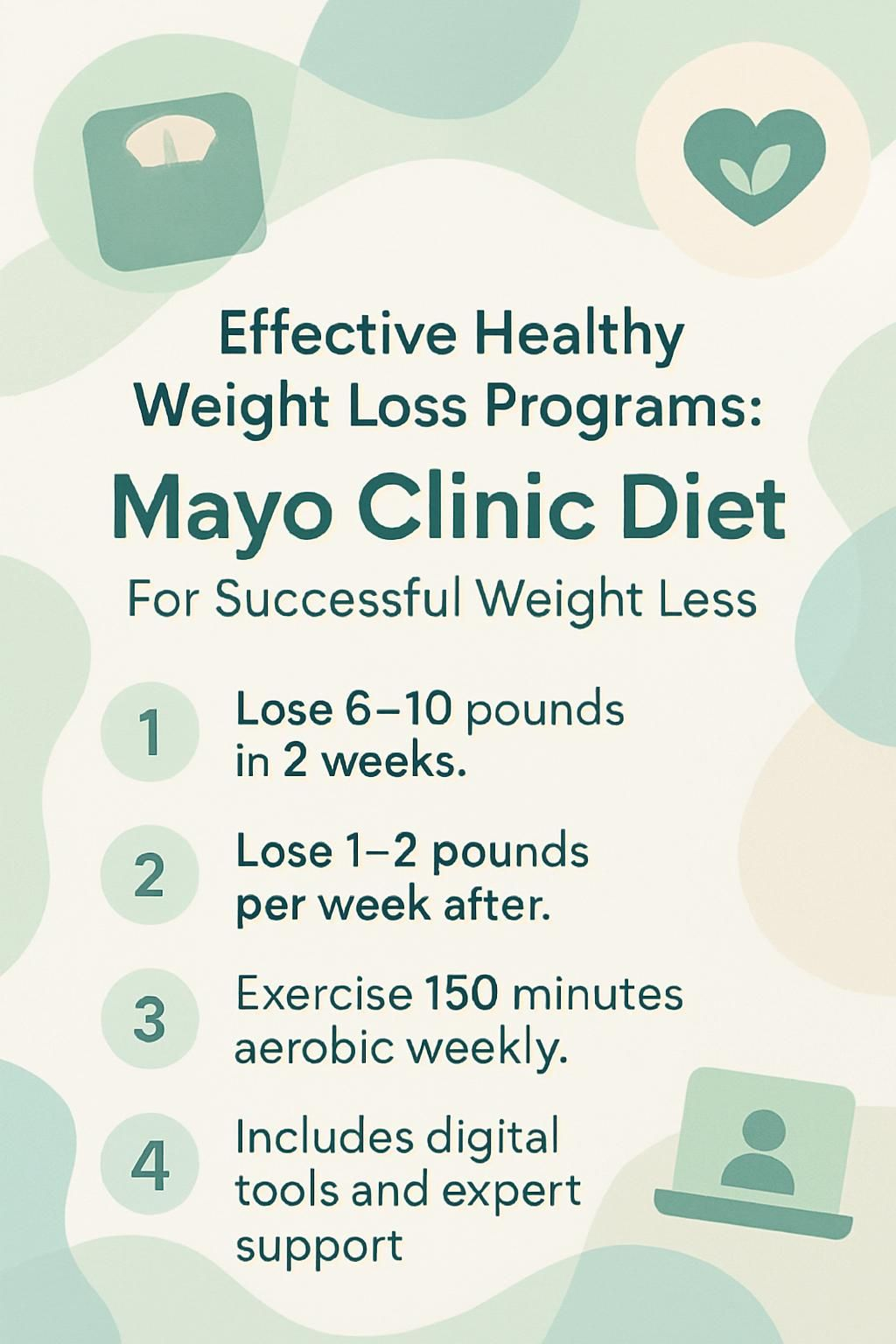Effective Healthy Weight Loss Programs: Mayo Clinic Diet For Successful Weight Loss
Our Nutrition Assistant AI Suite will transform your body. You will lose fat, get toned, and build muscle. Gain confidence and optimal health.
If finding a weight loss program that helps you lose weight and keep it off feels hard, you are not alone. The Mayo Clinic Diet is a long-term, doctor-developed plan built to support healthy, steady change. This guide explains how the program works, why it is backed by science, and what sets it apart from many diet plans. It could be a strong fit for your weight-loss journey.
Key Takeaways
- The Mayo Clinic Diet, ranked among the best diets for 2025 by U.S. News & World Report, is created by medical experts and based on decades of obesity research.
- Most people lose 6–10 pounds in the first two weeks during the Lose It! phase, then 1–2 pounds per week as new habits stick.
- Tools include the Healthy Weight Pyramid and flexible meal plans, including keto and vegetarian choices, without strict calorie counting.
- Regular physical activity, at least 150 minutes of aerobic exercise weekly, plus behavior-change support, can lower risks of heart disease, type 2 diabetes, and weight regain.
- Support features include digital tracking, coaching, access to nutrition experts, and learning resources that help both mental and physical health.

What is the Mayo Clinic Diet?

The Mayo Clinic Diet is a comprehensive weight management program built on healthy eating and regular movement. This evidence-based plan helps you reach your goal weight and maintain successful weight loss with daily, doable steps.
What does the Mayo Clinic Diet program include?
The Mayo Clinic Diet uses science to guide healthy weight loss. You get practical tools, meal plans, and expert strategies that support lasting results.
- The eating plan follows the Mayo Clinic Healthy Weight Pyramid. It steers you toward fruits, vegetables, whole grains, lean protein, and healthy fats.
- Simple digital tools help you log meals and activity, including a food journal and a weight tracker available online or in the virtual weight management program.
- You get more than 50 sample meal plans. One 1,200-calorie Mediterranean-style day might include overnight oats with berries for breakfast and Tuscan white bean soup for lunch.
- Portion control is encouraged without strict calorie counting. Desserts are set at about 75 calories per day or can be saved for later in the week.
- Learning resources cover label reading, goal setting, habit building, and how to handle setbacks during your weight-loss journey.
- Registered dietitians offer guidance on building healthy habits and making changes that last.
- Meal plans support many needs, such as vegetarian, plant-based, keto-friendly, and family-style options.
Next up: how the Mayo Clinic Diet supports sustainable weight loss.
How does the Mayo Clinic Diet promote sustainable weight loss?
You start by building healthy habits instead of chasing fast results. In the Lose It! phase, many people lose 6–10 pounds in two weeks by adding more vegetables, cutting unhelpful habits, and moving each day.
This program uses behavior-change science from Mayo Clinic experts. After the jumpstart, the Live It! phase teaches gradual loss, about 1–2 pounds per week, while building long-term routines.
Portions are easy to estimate using simple visuals. That lowers stress around food choices. You learn to plan meals with nutrient-dense foods and limit processed, high-calorie items that often drive weight regain.
Setting realistic goals keeps motivation strong. Tracking my daily steps helped me push past plateaus and lose over ten pounds in a safe, steady way.
This diet centers on everyday decisions that become part of your life, not quick fixes.
Recipes, digital tools, and coaching make it easier for busy people and families to stay on track. You will see why many choose this plan for a sustainable path to a healthy weight.
Why Choose the Mayo Clinic Diet?
You want a program that supports health for the long term and delivers real results. The Mayo Clinic Diet helps you lose excess weight while building habits that keep you well.
What are the success rates of the Mayo Clinic Diet?
Most participants lose about 6 to 10 pounds, or 2.7 to 4.5 kilograms, during the first two weeks of Lose It!. After that, steady loss continues at about 1 to 2 pounds per week if you follow the guidance on healthy eating and movement.
Research suggests people who stick with these habits can maintain a healthy body weight for years. Even modest weight loss can lower blood sugar and reduce the risk of heart disease and type 2 diabetes.
I followed this plan last year after seeing the U.S. News & World Report ranking. My results matched clinical trial expectations. The weight stayed off because I changed how I eat and move each day.
How is the Mayo Clinic Diet backed by medical expertise?
The Mayo Clinic Diet comes from a leading U.S. health system. Mayo Clinic specialists built the plan using decades of research on obesity, nutrition, and behavior change.
U.S. News & World Report ranks it among the best diets for 2025 because it relies on solid science instead of trends. Experts in obesity medicine view programs from medical centers like Mayo as safe, effective options for weight loss.
During a similar clinic-led program I tried, nurses checked my blood pressure and cholesterol. Seeing the numbers move in a healthy direction boosted my confidence.
A proven plan blends medical knowledge with practical steps so you can reach a healthy weight and protect your health.
Why focus on long-term lifestyle changes with this diet?
Mayo Clinic experts use a tested, science-based approach for lasting change. You replace unhelpful habits with positive routines. Small steps come first, like eating more fruits, vegetables, and whole grains while cutting added sugar and processed foods.
The program helps you build new habits at a realistic pace so you can maintain a healthy weight. Support includes meal planning, portion skills, regular activity, better sleep, and stress control. People who make these changes are far more likely to keep weight off five years later than those on fad diets.
The goal is steady change that supports your heart, digestion, and energy for years to come.
How Does the Mayo Clinic Diet Work?
This diet uses science to help you build healthy habits for successful weight loss. As you follow the plan, you can see positive shifts in both body and mind.
What are the “Lose It!” and “Live It!” phases?
The Mayo Clinic Diet has two phases that help you lose weight and keep it off. Each phase focuses on practical lifestyle changes and steady progress.
- Lose It! lasts two weeks and jumpstarts weight loss, usually 6–10 pounds, by adding five healthy habits, dropping five unhelpful ones, and adopting five bonus behaviors.
- Live It! is lifelong. It aims for 1–2 pounds per week through smart food choices, portion control, meal planning, and regular exercise such as walking or strength training.
- Guidelines are easy to follow and do not depend on strict calorie counting. You build sustainable behaviors without feeling deprived.
- Both phases focus on real foods high in dietary fiber and naturally low in calories, such as fruits, vegetables, fish, eggs, whole grains, yogurt, and plant-based choices.
- You use the Healthy Weight Pyramid to estimate portions and plan meals. This helps you avoid highly processed, high-calorie foods while keeping strong nutrition.
- Daily physical activity starts on day one. Walking and strength work help preserve muscle and support metabolism as you lose weight.
- Expert tools from Mayo answer common questions about nutrition, exercise for different levels, and stress management.
- The plan fits many lifestyles, including Mediterranean and vegetarian eating. It can be adjusted for families and busy schedules without sudden, extreme changes.
- During Live It!, long-term success gets easier with resources that guide meal choices and help you adjust based on how your body responds.
- Tracking my daily habits after the first phase helped me stay motivated and keep results without relying on medication or surgery.
- Research from the National Institutes of Health supports gradual loss like this. It can lower the risk of chronic conditions such as high blood pressure and type 2 diabetes while you build healthy behaviors over time.
How does the diet encourage healthy habits and behavior change?
The program uses behavior-change science to help you build better habits. You track food, activity, and sleep in a simple journal. Weekly weigh-ins show trends, not just single numbers.
These tools help you spot patterns and make small changes that add up. You also learn to curb mindless snacking, plan movement, and set clear goals. Those steps keep you moving forward, even after a tough day.
I learned to reach for nutrient-dense foods during stressful shifts instead of grabbing processed snacks. Next, see why consistent movement matters for weight and well-being.
Why is consistent physical activity important in this diet?
Movement is central to the Mayo Clinic Diet. Aim for at least 30 minutes of daily exercise to support weight loss and health.
Experts suggest 150 to 300 minutes of aerobic activity each week for best results. Regular activity burns calories, protects muscle, and supports a healthy body mass index.
Even without quick changes on the scale, daily movement helps your heart, brain, and digestive system. A brisk walk after work or a low-impact class can fit most schedules.
This plan promotes realistic routines rather than intense workouts on day one. Add time and intensity as your body adapts, and your energy often increases over time.
Core Principles of the Mayo Clinic Diet
The Mayo Clinic Diet teaches you how to make smart food choices and build a healthier approach to weight loss. These core ideas keep the plan simple and effective.
Choosing nutrient-dense, real foods
Pick foods rich in nutrients to support health and weight loss. Fill your plate with vegetables, fruits, whole grains, beans, nuts, fish, and sources of unsaturated fat like olive oil and avocado.
Research shows these real foods can lower the risk of diabetes and heart disease. Mediterranean-style eating uses these staples and delivers fiber plus key vitamins such as vitamin D.
High fiber meals might cause brief gas at first. Your body usually adjusts. When I shifted from fast food to bean salads and roasted vegetables, I felt fuller and had steadier energy within a week.
Choosing nutrient-dense foods helps curb cravings for processed diet food and keeps calories in check. That creates a strong base for long-term results.
Avoiding processed and high-calorie foods
Cut back on ultraprocessed foods and high-calorie snacks. Many people in the United States get most of their intake from these items.
Such foods often have empty calories, added sugars, lots of sodium, and artificial ingredients. Over time, this pattern can raise the risk of obesity, diabetes, heart disease, and even problems with memory.
Choose whole foods whenever you can. Swap chips for air-popped popcorn or choose fresh fruit instead of candy. When I stopped the nightly fast-food stop and cooked simple meals, my energy improved fast.
Evidence-based plans like DASH and USDA guidance also show that limiting processed foods supports healthy weight loss with better long-term results.
Following the Mayo Clinic Healthy Weight Pyramid
The Healthy Weight Pyramid guides daily choices. Eat more from the base, like vegetables, fruits, and whole grains. Limit items at the top, like sweets and processed snacks.
This structure helps you choose nutrient-dense foods that support health and weight loss. Many experts, including those at the National Institute of Diabetes and Digestive and Kidney Diseases, recommend this approach.
Use the pyramid to plan meals. I found it useful to load my plate with leafy greens or brown rice first, then add smaller portions of protein or dairy, as the plan suggests.
The pyramid also discourages calorie-dense processed foods that often drive weight gain. Clear serving examples help you follow the plan without strict calorie counting.
These steps make it easier for families and anyone seeking a personalized weight loss plan to succeed using proven methods.
Unique Features of the Mayo Clinic Diet
The Mayo Clinic Diet follows current nutrition science and gives you flexible options. Many people like that it works without strict rules, which makes it easier to fit your life.
How does the diet accommodate vegan, vegetarian, and keto needs?
You can choose from eight personalized meal plans, including vegan, vegetarian, Mediterranean, and keto. Each plan uses nutrient-dense foods to support weight loss while matching your needs.
If you prefer plant-based eating or need low-carb meals, the program lets you pick what fits. Menus also support people managing diabetes or heart disease.
The flexible format fits cultural and dietary preferences without strict calorie counts. I found the shift toward plant-based meals easy after my provider suggested reducing salt to support my health.
Helpful tools guide you to recipes and ingredients that match your goals and values. This flexibility compares well with plans like WeightWatchers or WW International.
Why is there no strict calorie counting?
The diet does not require strict calorie counting because it teaches portion awareness and prioritizes naturally low-calorie, nutrient-dense foods. This lowers stress and helps you follow the plan each day.
Programs such as WeightWatchers also allow many foods without tracking. A similar flexible style can improve consistency.
With this method, you focus on wholesome foods from every food group and avoid highly processed picks that add calories without nutrients. You build healthy habits instead of relying on rigid rules.
Many people find it easier to stick with this style over time, which raises the chance of reaching and holding a healthy weight.
What personalized meal planning options are available?
Skipping strict counting lets you focus on habits and real foods. Digital tools offer recipes, sample menus, and flexible paths for different health needs.
You can select plans that fit vegan, vegetarian, or low-carb styles. If you need diabetes-friendly or heart-smart options based on Mediterranean diet principles, you will find them here.
You complete a 100-point Mayo Clinic Diet Score habit check. It personalizes your plan to match your goals and routine. Registered dietitians also support you through video or email so your menu fits changes in goals or medical needs, including medication concerns.
Using these tools, I swapped some meat dishes for plant-based proteins. The planner created a weekly list that made shopping simple.
The program is delivered through an interactive hub. It supports your preferences while helping you meet nutrition needs. Ask a healthcare provider for guidance before starting any weight-loss program.
Benefits of the Mayo Clinic Diet
The Mayo Clinic Diet helps you lose weight and support better health. It works with your daily life and encourages gradual change that lasts.
How does it promote gradual, healthy weight loss?
You focus on steady loss through smart food choices and daily habits. Most people lose 6–10 pounds in the first two weeks of Lose It!, then 1–2 pounds per week in Live It!.
Progress comes from eating nutrient-dense foods and limiting processed, high-calorie items. You practice portion skills with the Healthy Weight Pyramid and add regular activity recommended by your healthcare provider or nutritionist.
For me, small changes became routine after a few weeks. This method supports progress without extreme dieting or rapid shifts that can harm health.
How does it reduce risks of diabetes and heart disease?
You lower risk for diabetes and heart disease by choosing whole foods and healthy fats. The plan guides you to nutrient-dense choices instead of processed or high-calorie items.
This shift supports steady blood sugar, reduces inflammation, and promotes weight loss. In programs like the National Diabetes Prevention Program, similar lifestyle changes cut the risk of type 2 diabetes by over 50 percent.
On this plan, I replaced sugary snacks with fruit. I felt fuller and had steadier energy. These daily choices protect heart health as well.
Following a plan with these priorities can help prevent risk factors tied to diabetes and heart disease, often without medication or surgical weight loss such as bariatric surgery or drugs like tirzepatide.
How does the diet improve mental and physical well-being?
The Mayo Clinic Diet supports mental health through structure, progress tracking, and social support. Counseling and group options help manage stress and boost accountability.
Studies show that structured support can improve mood and ease symptoms of depression for many people. Nutrient-dense foods deliver steady energy, which helps focus and daily performance.
Regular activity boosts endorphins, brain chemicals that lift mood, and also helps the heart and blood sugar control. A 2022 Mayo Clinic study reported fewer cravings, better sleep, and higher energy within eight weeks.
If needed, a healthcare provider can guide your progress. They may suggest tools such as semaglutide if results slow, or surgery when medically appropriate. Skills gained along the way help you make healthy choices each day.
Physical Activity in the Mayo Clinic Diet
Daily movement is a key part of this plan. Think of exercise as a steady engine that keeps your progress going.
Why is daily movement important in the Mayo Clinic Diet?
Regular activity helps prevent muscle loss during weight reduction. It also supports weight stability after you reach your goal, which reduces the risk of regain.
Moderate activity can lower the risk of heart disease and type 2 diabetes. Many people find daily walks or light routines easier to maintain than intense workouts.
When I added a short walk after dinner, I felt more energetic and found it easier to stay on plan. These small steps add up.
The next section shows exercises the program recommends for strong results.
What exercises does the diet recommend?
Movement supports health and steady weight loss. The Mayo Clinic Diet recommends a mix of activities.
- Aerobic work is central. Try brisk walking or cycling for at least 30 minutes most days to burn calories.
- Strength training builds lean muscle, which can raise your resting metabolism. Do resistance work with weights or bands two days per week.
- Pick activities you enjoy to stay consistent. Swimming, jogging, dancing, and team sports all count.
- Use daily tasks to add steps. Take stairs, park farther away, or do yard work.
- Flexibility and balance help prevent injury. Stretching or yoga can support your goals.
- Track progress with an app or journal. Share updates with your health care provider for feedback.
- Start easy if you are new to exercise. Talk with your provider before any weight-loss plan, especially if considering surgery or other options.
Doing these regularly can help you lose weight safely without crash diets or risky routines.
What’s Included in the Program?
The Mayo Clinic Diet includes helpful information, practical tools, and fresh resources to support healthy weight loss. Here is what you get.
Meal plans and recipes
Meal plans and recipes are central parts of this program. Each plan supports health while encouraging steady, sustainable weight loss.
- Eight personalized meal plans, such as Mediterranean, keto, and vegetarian, let you choose what fits your routine.
- Sample days may include overnight oats for breakfast, bean soup for lunch, roasted chicken with vegetables for dinner, and fruit-based snacks.
- Plans avoid highly processed foods and highlight nutrient-dense choices from the Healthy Weight Pyramid.
- Many plans target balanced nutrition. A sample 1,200-calorie day provides satisfying meals without extra calories.
- Recipes use common supermarket foods, which keeps cooking simple for busy people and families.
- Portion guides replace strict calorie counting. That makes mealtime decisions easier.
- As a busy parent with deadlines, I found the weekly grocery lists made healthy eating easier to maintain.
- Each plan includes tips for swapping ingredients to fit vegan, vegetarian, or keto needs. This supports different preferences and restrictions.
- Resources also include quick-prep recipes for hectic schedules with strong results.
Educational resources and tools
The program gives you a wide set of learning tools. These help you build skills, track progress, and stay committed.
- An electronic food and exercise journal makes daily logging simple.
- A digital weight tracker shows your trend over time and keeps you motivated.
- The Mayo Clinic Diet Score tool rates your current habits and offers feedback to guide change.
- Educational content focuses on habit building that sticks rather than quick fixes.
- Behavior guides explain how new choices affect mental and physical health, so lessons make sense in daily life.
- Personal goal-setting helps you plan realistic targets and stay accountable.
- Recipes, meal plans, grocery lists, and interactive modules fit busy schedules and family needs.
- Articles, videos, and quizzes from Mayo Clinic doctors and nutrition experts reinforce evidence-based advice.
- Support options include member forums, email tips, and motivational check-ins so you feel connected.
These tools form a program that supports consistent progress and long-term results.
Support options for motivation and accountability
Support can help you stay inspired and accountable. The Mayo Clinic Diet offers several options backed by behavior science.
- Group sessions provide a safe space to share challenges and wins with others on the same path. Trained experts lead them in person or online.
- Individual coaching gives one-on-one guidance. A health professional helps create a plan, tracks your progress, and motivates you with expert advice.
- Virtual communities allow daily connection with members working toward similar goals. Research shows social support can improve outcomes compared with going alone.
- Educational webinars share ongoing tips from Mayo Clinic staff. Topics include sustainable habits, meal planning, and how the program may affect your results.
- Progress trackers let you log meals, movement, and milestones. Visual trends keep motivation high.
- Email reminders provide timely encouragement when life gets busy.
- Group support helped me during plateaus. Honest sharing reduced self-doubt and pushed me forward.
Each support feature uses proven strategies that strengthen accountability and community, which are key for steady change.
Can the Mayo Clinic Diet Be Tailored to Different Lifestyles?
You can adjust the Mayo Clinic Diet to fit many routines and personal needs. It works for busy professionals, families, and anyone wanting a flexible approach to healthy eating and weight management.
How does the diet fit into busy schedules?
Meal plans and recipes focus on simplicity. Most meals are ready in about 30 minutes. Grocery lists use common items to save time.
Digital tools let you log meals and progress in seconds from your phone or computer. Coaching features add reminders and quick suggestions, so planning does not take hours.
I used this program during a heavy workweek. Prepping meals with the provided recipes made healthy choices realistic, not stressful.
The plan adapts to individuals or families with hectic schedules. Guidance fits into lunch breaks or evenings after work, which makes success possible even on busy days.
The same flexibility supports families who need options for different tastes and needs.
What options are available for families or individuals?
You can choose a program customized to your situation, whether you live alone or share meals. The Mayo Clinic Diet offers adaptable menus so everyone can find something that fits.
Families can follow plans together, which makes healthy eating easier at the table. If you prefer personal support, one-on-one coaching keeps you motivated and accountable.
Group options let families or friends tackle challenges together while using personalized resources. As a parent, this structure made weeknight dinners smoother because everyone knew what to expect.
Clear instructions keep shopping simple and save time. You get tools and community features that support both shared goals and individual progress.
Results You Can Expect
As you follow this program, you can expect steady progress. Many people notice positive changes in both their weight and daily habits over time.
What is the average weight loss on this diet?
Most people lose 6–10 pounds, or 2.7–4.5 kilograms, in the first two weeks of Lose It!. This early success helps build momentum.
Afterward, weekly loss is usually 1–2 pounds, or 0.5–1 kilogram, during Live It!. The pace can vary based on your needs and lifestyle.
These results feel encouraging because you can see steady progress without extreme rules. The program’s flexibility helps many people stay consistent.
The focus is healthy habits that support long-term weight control, not quick fixes.
How sustainable are the long-term results?
Long-term results with the Mayo Clinic Diet are promising. Research on TOPS Club, which uses similar principles, shows members who stay active in the program can keep off 5 to 7 percent of their weight loss for up to seven years.
Ongoing support and community help maintain results. Staying involved raises your chance of success over many years.
The program adapts to your lifestyle, which makes it easier to keep healthy habits. Many people see durable results because they learn practical skills and get steady encouragement.
Are There Risks to the Mayo Clinic Diet?
The Mayo Clinic Diet can be adjusted for many needs, but some people may face health concerns. Talk with a healthcare professional before starting any weight loss plan to make sure it is safe for you.
What potential concerns should be considered?
People with diabetes or other conditions may need a modified plan before starting. Some notice temporary digestive discomfort, like gas or bloating, when they add more fiber. This often eases as your body adapts.
When I began the plan, paying attention to my body helped reduce these symptoms. If you have medical issues, ask your doctor how to adjust the program for your situation.
Next, see why checking with a healthcare professional matters before you begin.
Why consult a healthcare professional before starting?
Knowing potential concerns helps you make safe choices. A healthcare professional can check for risks related to your health history, medicines, or current symptoms.
People with diabetes may need to emphasize vegetables over fruit and may require expert advice on snacks and timing. Research from Mayo Clinic shows that medically guided programs can improve safety and results[1].
Talking with my doctor helped me shape the plan to fit my goals. A provider can review medications, suggest activity levels, and monitor progress. This personal support can reduce side effects and improve long-term success.
…
[1] Mayo Clinic Staff. “Mayo Clinic Diet: A Weight-loss Program for Life.” Mayo Clinic, 2024.
Tips for Success with the Mayo Clinic Diet
You can improve your results by using the program’s resources. The plan can be customized to support your needs during your healthy weight loss journey.
How do you set realistic goals?
Set goals that match evidence-based guidance. The National Institutes of Health recommends aiming for 1 to 2 pounds per week. Break big targets into smaller weekly steps that fit your day.
Pick clear actions, such as walking 30 minutes daily or using the Healthy Weight Pyramid to plan meals. Simple actions are easier to repeat.
Track progress and adjust as needed. Attending regular support meetings helps with accountability. Studies suggest attending at least 25 meetings per year improves long-term results.
Setting weekly goals with measurable outcomes helped me stay focused during tough weeks. It kept my habits steady and my motivation up.
Why is consistency and patience important?
Weight loss takes time and steady habits. You make lasting progress by following your plan every day, even when results are slow. Mayo Clinic experts note that quick-fix diets often lead to weight regain.
A program can be customized for your needs, but it still takes daily effort. Patience helps your body adjust and your habits stick. Most people see meaningful changes over weeks and months.
Steady loss of 1 to 2 pounds per week is safer and more likely to last than rapid loss. Consistency also lowers the risk of gaining weight back later.
How can you use available resources effectively?
Consistency and patience lay the foundation. Using resources gives you extra support. Food and activity journals help you see patterns and spot small changes to make.
Digital tools give fast feedback on calories and nutrients so you can adjust in real time. Educational materials explain balanced nutrition, which makes daily choices simpler.
Support groups boost motivation. Coaching adds personal guidance when you hit a snag. I used an app to log meals and joined weekly virtual meetings. That combo kept me accountable and steady.
These methods work best when used together. They connect to your routine and reinforce each other for stronger results.
How Does the Mayo Clinic Diet Compare to Other Programs?
You can compare this plan to other popular options based on your goals and preferences. The Mayo Clinic Diet offers a more sustainable approach that fits real life.
How is it different from other popular diets?
The Mayo Clinic Diet does not cut out entire food groups or require strict calorie counting. Some trendy plans, such as keto and paleo, exclude broad categories of foods, which can be hard to maintain for years.
This program adapts to your needs and teaches smart choices using real, nutrient-dense foods. It also provides behavior tools and digital resources instead of relying only on willpower.
Meal plans are backed by medical experts from Mayo Clinic. Education and tracking tools help you build habits that last. The focus is small shifts, not extreme rules.
Why is it considered a sustainable option?
Many popular diets promise fast results through restrictions. The Mayo Clinic Diet focuses on enjoyable habits that fit your life. Experts in obesity medicine guide you with strategies grounded in research.
You eat whole foods and practice new behaviors without cutting entire food groups or counting every calorie. This improves adherence. People tend to keep up routines that match their real lives.
Programs from medical centers like Mayo emphasize progress, not perfection. That helps prevent burnout and rebound weight gain.
Who Should Consider the Mayo Clinic Diet?
This plan is helpful if you want an evidence-based program that can be customized to your needs. Many people use it to support lasting weight management.
Who is the ideal candidate for this diet?
You are a good fit if you want a medically developed plan with structure and ongoing support. It works well for people who value guidance and have struggled to keep weight off with other diets.
If you prefer sustainable change over quick fixes, the Mayo Clinic Diet can match your goals. It also fits busy adults, families, and those who like real foods more than processed options.
The plan supports both beginners and those restarting their health journey. It offers structure with enough flexibility to keep going.
Who benefits most from the Mayo Clinic Diet?
People at risk for diabetes, heart disease, or high blood pressure often see strong benefits because the plan emphasizes whole foods and regular activity. Plant-forward eating patterns can reduce heart events in adults over time.
Those committed to gradual, permanent changes tend to achieve steady results. If you want healthy habits instead of quick fixes, this plan can support weight loss and long-term wellness.
The flexible framework adjusts to different needs while delivering progress across many health goals.
Conclusion
Choosing a healthy weight loss program can feel confusing. The Mayo Clinic Diet offers clear, science-backed guidance that supports steady progress and better health. It works with your life, whether you cook for one or feed a family.
With expert support and flexible meal plans, you build confidence as you lose weight safely. Daily movement and real food keep your body strong and may lower the risk of heart disease and diabetes. If you want results that last, this program can help you reach your best weight at a pace that fits your lifestyle.
FAQs
1. How is the Mayo Clinic Diet program tailored for individual needs?
The Mayo Clinic Diet program can be tailored to fit different health goals, lifestyles, and food preferences. This customization helps users follow a plan that matches their unique requirements.
2. Can the program be tailored for people with medical conditions?
Yes, the program can be tailored for those with specific medical conditions such as diabetes or high blood pressure. Health professionals often recommend adjustments based on personal health data and nutritional needs.
3. What makes a weight loss program effective according to research?
Research shows that an effective healthy weight loss program uses evidence-based strategies like calorie control, regular physical activity, and behavior changes. The Mayo Clinic Diet follows these principles using credible guidelines from clinical studies.
4. Is there proof that tailoring a diet improves success in weight loss programs?
Studies suggest that when a program is tailored to individual habits and preferences, participants are more likely to stick with it long term; this leads to better results in losing weight and keeping it off over time.
Summary: A successful healthy weight loss approach includes evidence-based methods and personalization of plans; tailoring increases adherence rates which supports lasting results according to scientific findings.







